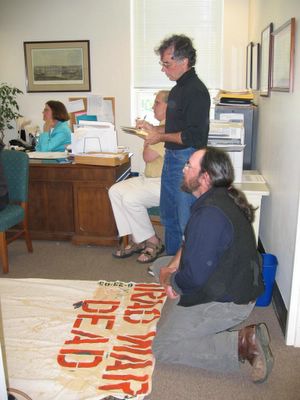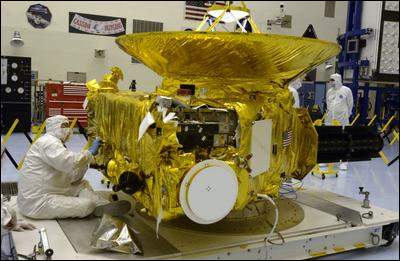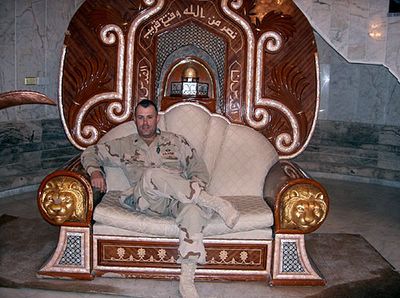
Portland Phoenix
December 14, 2005
By Sara Donnelly
Last December, 13 anti-war activists gathered in Senator Susan Collins's office in Portland. They read the names of the American soldiers who had died to date in the Iraq War, as well as an equal number of Iraqi civilians who died. They occupied Collins's office for roughly four hours and, before they left, asked the senator to hold a "town meeting" to discuss the war with her constituents.
On February 4, 17 Maine peace activists gathered in the Portland offices of Senator Olympia Snowe. Again, they read the names of the American soldiers who had died in the Iraq War and an equal number of Iraqi names — over 2000 total by that date. This time, after someone read the name of each war-dead, they marked an X, in red or black marker, on a giant sheet of cloth to demonstrate the enormity of the loss. They then asked Snowe to meet with her constituents in a town meeting on the war.
On March 18, 35 people gathered in Representative Tom Allen's Portland office. They repeated the February action's format.
The names of the war dead were read, X marks were drawn on a white sheet, and, at the end, the request for a town meeting.
On June 23, 100 people gathered to protest the war in front of Collins's Bangor office.
About a month later, on August 26, another occupation occurred in Collins's Lewiston office. Someone brought a bell, which rang after each name was read.
Then again on October 14, at Snowe's office in Biddeford. The names, the sheet, the bell, the request for a town meeting.
All told, there have been six nearly identical occupations of Maine's congressional delegates' offices (as well as several informal meetings with US Representative Mike Michaud), each lasting between four and six hours, each designed to slowly and somberly disrupt business as usual. It's all part of a statewide, coordinated action called the "Frequent Visit Program," founded a year ago by some of the state's most fervent anti-war activists.
Since the start of this anti-war occupation effort, Allen and Michaud have agreed to the activists' request to hold a town meeting on the Iraq War. Maine's FVP activists are well aware the time is ripe to use congressional leaders to get the anti-war message to the Prez, thanks to plummeting public support for the war and anti-war lightning rods like Cindy Sheehan and US representative John Murtha. So FVP creators are marketing their model nationwide.
The ready-to-wear war-resistance model — an office occupation, a roll-call of the dead, a request for public dialogue — has already been used in a handful of other states thanks to FVP outreach through correspondence, training brochures, and a DVD. Forget moose and blueberries — Maine now has its own little peace action franchise.
Frequent Visit is founded on a premise so basic it seems like common sense: To get things done, you need to sway your local legislator. Visitors focus on national legislators exclusively and leave the vigils and massive marches for another day.
The plan is simple. First, Visitors call or visit the offices of Maine's congressional delegates in small groups of three or four. They request private meetings to discuss their concerns about the war. If they haven't gotten a meeting after several attempts, they stage a sit-in, referred to most often as an "occupation," in which they eulogize the Iraq War dead. They ask for a town meeting, open to the public, in which the congressional delegate can discuss his or her policies on the war with constituents. If they don't get a commitment, or a reasonable promise of one, they make phone calls, send letters, write e-mails, several times a month, over and over and over, asking for a town meeting. It's frequent, pointed pressure. Visitors are the guests who won't leave.
Now, within this model, there's room for variation. Since the activist movement in-state and beyond is chronically non-hierarchical and as dynamic as sand in a windstorm, Visit actions can vary. Sometimes they're outside the office. Sometimes, they're inside. The core group of organizers changes according to which peace group is based closest to the action. The next action, on December 15, the day of parliamentary elections in Iraq, at Senator Snowe's office in Bangor, will break with FVP tradition and include a press conference and forgo the reading of the names. FVP activists, also, for the first time in the program's history, plan to occupy the office that day until they receive a response from the senator to their concerns about the war. FVP co-founder and longtime activist Bruce Gagnon thinks it might be the first time he gets arrested on an FVP mission.
Despite the December variation, FVP's strength lies in its relative consistency.
Gagnon and the handful of Maine activists who created FVP watched Allen hold a town meeting on the war in Portland last July and this month received the promise of one in Bangor from Michaud. But the senators have been a tougher sell. Kevin Kelley, a press secretary for Senator Susan Collins, says the senator "welcomes the communications from constituents" but prefers to meet one-on-one rather than in large, town hall meetings.
Antonia Ferrier, press secretary for Senator Olympia Snowe, says the senator has not "ruled out" a town meeting but no plans have been made to hold one.
"[Senator Snowe] wants to be able to hear from [the Visitors] as well as any Mainer about how they feel on any issue," says Ferrier. "That helps her formulate her policy and explain to her colleagues in Washington what she’s hearing at home and what the political will is of her constituents."
Despite our reluctant senators, as Gagnon says, "two of the four pillars have fallen." The Visit program, only one year old, has fostered some real discussion on the war with the state's DC delegates.
"We've been getting more and more people coming out of the woodwork wanting to be a part of this," says Gagnon, of Brunswick (see "Becoming a Visitor"). "That really says something about the state of activism. People are desperate; they just want to become a part of something."
Gagnon based Visit on the 1930s General Motors plant sit-down strikes conducted by the United Auto Workers in Flint, Michigan. That movement is recognized in activist circles as one of the most important labor-rights strikes in American history. The FVP model has been used in Massachusetts, New Hampshire, Maryland, Illinois, and Pennsylvania. Some of the occupations have resulted in a town meeting on the war. Others have ended with activists spending a few days in jail, though the Maine Visitors have never been arrested during an occupation.
Maureen Block, an activist from Swanville, became hooked on the Visit program from the first meeting she attended in March. Block heard about plans for the March occupation of Allen's office from friends, the same way most Maine activists learn about demonstrations, and was struck by how organized the sit-in was.
"The Frequent Visit Program was the first thing that was presented to me that would produce tangible results," Block says. "It was direct action in the offices, making statements with a clear purpose. It was a way to really get directly involved in something that made sense to me."
Gagnon and others who founded the program — including Karen Wainberg of Peace Action Maine, Dud Hendrick of Maine Veterans for Peace, and Pat Wheeler, an artist and activist from Deer Isle — hope activists in other states will adopt the format to put pressure on their own congressional senators and representatives. Wheeler has filmed four of the six occupations to date and edited hours of footage into 20-minute montages set to folk music which she sends to activists in the state and around the country. At an anti-war demonstration in Washington DC last September, Visitors handed out hundreds of flyers on how to recreate the program. Wheeler and other Maine activists frequently send informal e-mails to their activist buddies in other states talking about FVP. They talk about it on activist listservs. They hype it to their friends over coffee. "The good, old-fashioned, grassroots word-of-mouth network is the best way," says Gagnon.
"We felt that we created a model which could be recreated across the country," says Wheeler of Visit. "We try to encourage [other states' activists] to organize a new group of people that haven't done this before to teach them to do an effective office visit. We wanted more people to repeatedly visit the offices [of congressional representatives] because we've sent countless petitions their way, we've made phone calls and sent e-mails and it seemed too easy to ignore. We thought visiting their office in person would make a difference."
Francis Crowe, an 86-year-old peace activist from Northampton, Massachusetts, received one of Wheeler's DVDs and an e-mail from Gagnon about Frequent Visit. She conducted an office occupation with her group, the Quaker organization the American Friends Service Committee, in May 2005. Crowe and eight others sat in the Springfield office of Democratic congressional representative Richard Neal and read the names of the American soldiers killed in Iraq and an equal number of Iraqis killed. For each name, one of the activists stamped a stick figure on a white sheet. Crowe says by the end of the meeting, Neal had personally committed to a town meeting with district constituents.
"[Neal] had been absolutely unreachable about the war in Iraq," says Crowe. "That day [his staff] said he wasn't reachable. But eventually, after the local newspaper called his office [about the demonstration], someone from the office came out to the reception room to say that Neal would be out to see us. In the dialogue with him we were able to get what we wanted which was for him to come to Northampton and hold a community meeting on the war and to spend an hour and a half answering questions and explaining his policy. But he hasn't signed on with [US representative] John Murtha or the [US representative James] McGovern bill, so I think we need to go back."
Pennsylvania Democratic congressman and notorious war hawk John Murtha sparked debate on Capitol Hill in November when he called for US withdrawal from Iraq in six months. Massachusetts Democratic congressman James McGovern's bill cuts off US money for the war.
On December 5, Anne Miller, director of New Hampshire Peace Action in Concord, was arrested along with eight other Peace Action activists while conducting a Frequent Visit-style occupation in the Concord office of Senator Judd Gregg. Miller, who did not know that the Maine program has a name, spoke with Gagnon in February and adopted most of the program's details for the occupation earlier this month.
"The call has come from all over the country for direct action," says Miller. "But I would say that Maine has provided a really wonderful model."
Bill Dobbs is the Media Coordinator for the United for Peace and Justice Coalition, based in New York City. Founded during the buildup to the Iraq War in 2002, the coalition is now the largest anti-war collective in the country, with some 1200 member groups in all 50 states and around the world. Member groups include small grassroots organizations with 10 or fewer activists to established anti-war groups like Peace Action and Veterans for Peace, each with thousands of members. Dobbs says this summer activists nationwide seemed to shift their focus to their congressional representatives. Dobbs believes the shift is the result of a number of factors, including the emergence of prominent anti-war voices in activist circles and in Congress.
"Congress is a great pressure point," says Dobbs. "There's a big gap between what the will of the American public wants and Congress and the Bush administration."
Dobbs says local work like FVP is as important to the anti-war movement as massive demonstrations in Washington DC and New York City. He believes local and national demonstrations fuel discussion on the war together — not only by showing growing numbers of voters oppose the war but by demonstrating the emotional toll on average Americans through vigils, word-of-mouth, and local actions like occupations.
"The national work and the local work are dove-tailing," says Dobbs. "There is a surge of interest in the last number of months in holding Congress accountable. Congress gave Bush the authority to wage this war and has continued to give him the money to wage it."
Gagnon, who worked as an activist in Florida before moving to Maine three years ago, says the number of activists here is unusually high, which helps regular actions like FVP. And, for an undefined war in which more than 2100 American soldiers have died and tens of thousands more Iraqis, Gagnon believes activists — or just concerned Americans — have to commit to more than the occasional demonstration or coffee-shop argument.
"Democracy is a participatory sport," he says. "If you don't exercise the muscles, they grow flaccid and weak."














